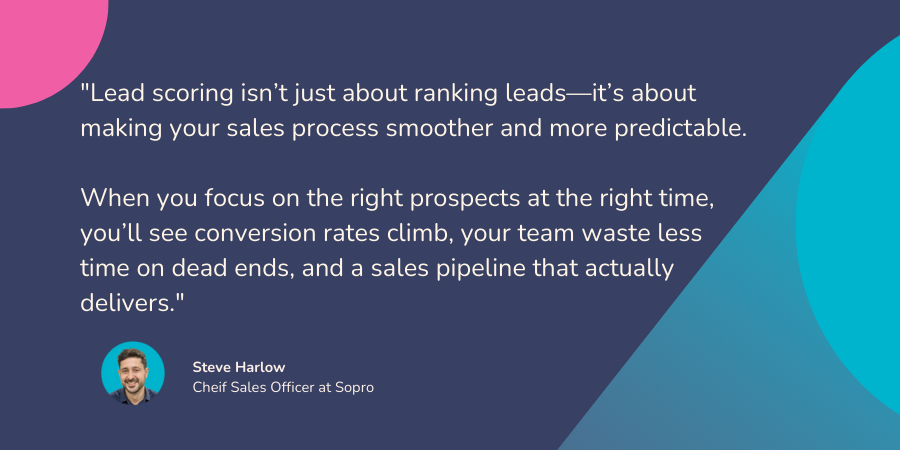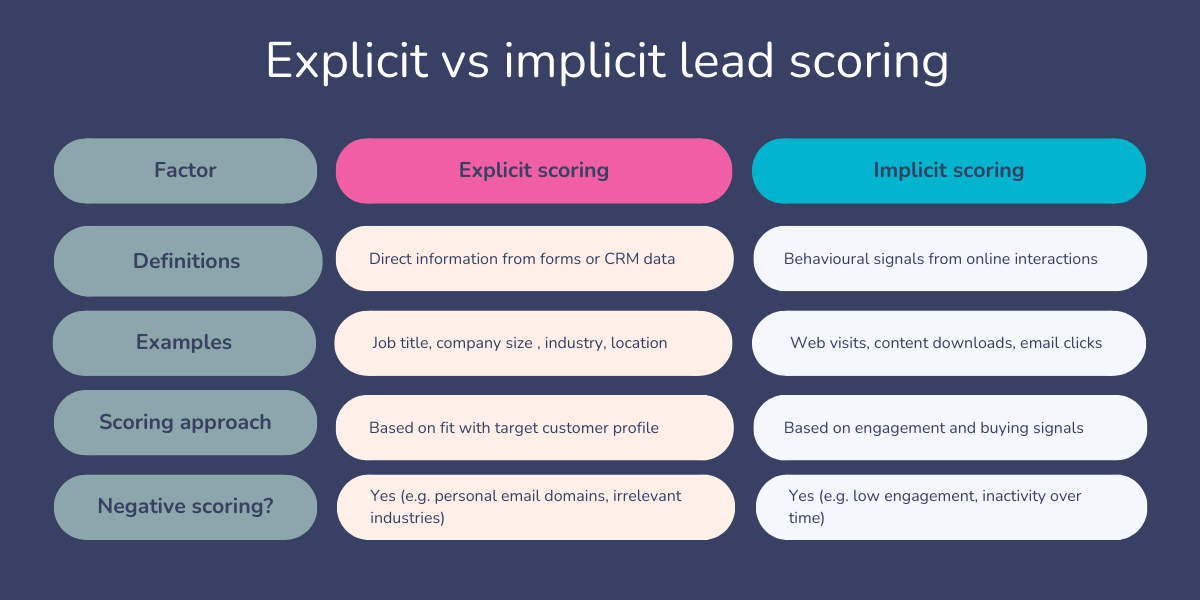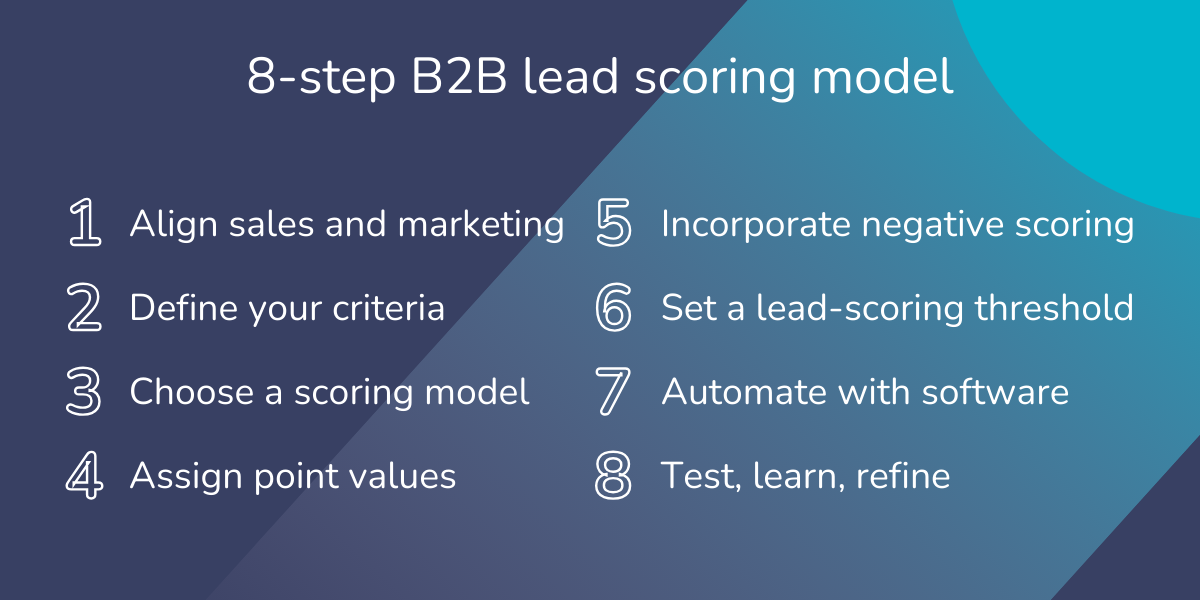What is lead scoring? A complete guide for businesses
In this blog

In today’s competitive business landscape, understanding your customers and focusing your efforts on the right prospects can make all the difference. This is where lead scoring comes into play.
Lead scoring is a powerful strategy that helps businesses prioritise their leads, ensuring they pour their marketing and sales efforts where they matter most.
But what exactly is lead scoring, and how can it transform your approach to generating and converting leads?
Here, we explore everything you need to know, from the basics of lead scoring to practical steps to implement it in your business.
Lead scoring should be central to your prospecting and lead generation processes regardless of whether you need lead generation services for SMEs or an enterprise lead generation agency. This guide equips you with the knowledge and tools to maximise your lead scoring efforts, optimise lead management and, ultimately, drive better results.
What is lead scoring?
Lead scoring is a way of assessing the quality of your leads and examining their likely value to your business. It involves a systematic process of assigning a value to your leads based on various attributes such as their behaviour, demographics, and firmographics.
These values help sales and marketing teams determine a lead’s potential to become a paying customer. Teams can then use this score to focus on high-quality leads or disqualify others from further lead nurturing.
What are the benefits of lead scoring?
The primary benefits of lead scoring include:
- Increased sales efficiency: By prioritising high-value leads, sales teams can focus their efforts where it matters most.
- Improved marketing strategies: Marketing teams can tailor campaigns to attract high-scoring leads.
- Better alignment between sales and marketing: Consistent criteria for evaluating leads ensure both teams are on the same page.
- Higher conversion rates: Focused efforts on high-potential leads typically result in higher conversion rates.
Why is lead scoring important?
Mastering lead scoring qualifies high-value prospects to maximise marketing and sales teams’ efficiency.
By understanding the key attributes, building a robust model, incorporating automation, and continuously refining your approach, you can ensure your lead-scoring strategy drives business success.
Remember, the ultimate goal is to focus your efforts on the leads most likely to convert, resulting in higher revenue and a more efficient sales process.
Want to find out how Sopro can help fill your sales pipeline so you can score and close the leads your business needs? Check out our B2B lead generation service and get ready to see your sales soar.

How does lead scoring work?
Lead scoring is based on two types of information: explicit and implicit scoring.
Explicit scoring
Don’t worry; this type of scoring is safe for work!
Explicit scoring is based on information the prospect tells you directly, for example, when they complete a data capture form.
Typical explicit data includes a BANT (Budget, Authority, Needs and Timeline) assessment based on:
- Job title/role
- Company size
- Industry
- Location
Implicit scoring
By comparison, implicit scoring is information you infer about the prospect, usually from their online behaviour (although you can also use offline behaviour). This behaviour could be:
- Revisiting the website blog or product pages
- Downloading whitepapers, product specs or manuals
- Opening an email and clicking on a link
- Registering for a webinar and/or attending a webinar
It should be immediately apparent that not all actions are equal.
In the examples above, the second of each pair will receive a heavier weighting as it is a stronger buying signal.
Sometimes, these differences are classed as examples of latent vs active buying behaviour.
Some lead scoring factors will be scored negatively rather than positively.
Examples of these could be students rather than employees, those who live in countries not served by the company, those using common email domains – such as gmail.com – rather than corporate domains, and those whose ‘inferred company’ name based on the IP address maps to an ISP rather than a corporate domain.

What are the key attributes of a lead scoring model?
So, how do you sort unqualified leads into ready-to-buy potential customers? To create a lead scoring model, you first need to decide on the factors and actions that matter and mark someone out as a good fit for your business.
These lead scoring criteria should include:
Demographic factors
Demographic attributes refer to the characteristics of the individual lead, such as age, gender, job title, and income level. These factors can indicate whether a lead falls within your buyer personas.
Firmographic factors
Firmographic attributes are all about the characteristics of the lead’s company, such as industry, company size, and revenue. These factors help determine if the lead’s company fits your ideal customer profile.
Engagement data
Engagement attributes track the lead’s engagement with various touchpoints. These will include email opens, content downloads, and interactions with your social posts. Ultimately, factors like these indicate that the lead is engaged with your content and currently holds a level of interest that warrants further consideration from your team.
Buyer intent data
Buyer intent data is a growing area of sales and marketing intel. It reveals previously hidden actions that show when a prospect is displaying purchase intent, like visiting your website repeatedly or viewing key pages like pricing.
Do you need lead scoring?
To really benefit from lead scoring, you need to make the leap beyond using just a CRM and invest in marketing automation software to complement it. Only the most basic level of scoring can be carried out by CRM alone.
Although lead scoring is not difficult to implement, it does require a commitment to regular reviews and an in-depth understanding of exactly who your target customers are.
There are three questions to ask yourself before you go down the lead scoring route to assess your readiness.
1. Are there enough leads in my pipeline?
If your sales team doesn’t even have enough leads to make qualifying an issue, then lead scoring is not for you.
2. Is your sales team contacting the leads you generate?
Your organisation needs a good sales and marketing alignment to create the necessary feedback loop that lead scoring relies on.
If there is an existing alignment issue, introducing lead scoring will only exacerbate, rather than fix, the problem.
Concentrate on creating – as a minimum – a service level agreement (SLA) that clarifies how many leads marketing must deliver to sales and how many sales must follow up with.
3. Do I have the means to capture the data I need?
You will need two types of data:
- Explicit (usually captured by forms)
- Implicit (usually captured by analytics and lead management platforms).
Without these in place your lead scoring system will be, at best, incomplete and, at worst, highly misleading.
Your focus should be, first of all, on improving the quality of the lead generation data you can capture and use from your marketing activities.
How to implement lead scoring
If you’re good to go, there are some big wins out there.
Analysts agree that lead scoring can truly skyrocket conversion rates in companies where sales and marketing teams are collaborating closely and continuously. According to Douglas Burdett, lead scoring can increase a sales team’s closing rates by as much as 30%.
So, how can you implement your own lead scoring?
Remember your goals
The first step is to keep the fundamental reasons for introducing a lead scoring system front of mind. This is your “why” – the guiding principles at the heart of your efforts to streamline and supercharge your sales processes.
These are:
- To avoid potentially off-putting sales contact at the early stages of lead nurturing. Instead, your goal is to progress and track leads through the sales funnel by serving content best suited to their stage on the customer journey.
- To maximise your sales team’s efficiency by identifying sales-ready leads.
Define a marketing-qualified lead
You need to determine the criteria for a marketing-qualified lead (MQL).
Both sales and marketing must agree on this, and you’ll need to carry out regular reviews based on analysis and feedback.
You will need to identify both explicit scoring factors, such as demographics, and implicit scoring factors, such as online behaviour.
Here are some of the things you’ll want to explore:
Explicit scoring factors
- Are VP-level executives more important than others?
- Are certain industries key to your sales?
- Which countries do you not service?
- Are small companies as important as enterprises?
- Are specific departments or job roles critical in making buying decisions?
Implicit scoring factors
- What actions indicate buying readiness (e.g. requesting a demo/specific information)?
- Which pages on our site indicate consideration?
- Can we define top-of-funnel activity (eBooks, webinars) and middle-of-funnel activity (pricing pages, product video demo)?
- What is the expected timeline – or number of touchpoints – before an MQL converts to a customer?
Pssst. Want to learn more about marketing qualified leads (MQLs)? Check out our expert’s guide to get the low-down on MQLs vs SQLs.
Create the scores on the doors
Once you’ve identified and agreed on the criteria for an MQL, you need a points system to rank the various scoring factors and a threshold at which a lead becomes an MQL.
Here’s a quick example:
One of your buying personas is a decision-maker at a large company. You know that leads typically visit at least five pages of your website and view at least one pricing page.
These factors would be weighted to ensure that anyone meeting all three would become an MQL and be considered ready for sales team contact.
An 8-step B2B lead scoring model
So, how do you actually implement all this in a real-world scenario? Don’t sweat it; we’ve got your back. Our lead generation gurus have outlined an eight-step plan to walk you through the lead scoring best practices, with actionable steps and key recommendations.

Step 1: Align sales and marketing teams
Every effective lead scoring hustle starts with close collaboration between sales and marketing teams. Establish regular meetings to discuss what makes a good lead, share insights, discuss demos, and assess quality from different channels. The idea is to ensure that both teams are aligned in their understanding and application of the lead scoring model.
Create a feedback loop where the sales team can share their experience with lead quality. If your CRM can record sales calls, get the marketing team to watch a sample regularly. This feedback is essential for refining and improving the lead scoring model’s accuracy.
Step 2: Define your criteria
Begin by identifying the key attributes that signify a high-quality lead. Collaborate with your sales and marketing teams to gather insights and establish a comprehensive list of criteria.
Real-world tip: Use surveys or direct feedback from your best customers to understand the attributes that led them to choose your product or service. This can help you refine your criteria further.
Step 3: Choose a scoring model
To implement a lead scoring model, you need to turn your defined criteria into point values and then into actionable insights. Here’s how to effectively set up your process:
Choose a model
First, decide on the scoring model that suits your needs. You can opt for a simple linear model where each factor has equal value or a more complex model that assigns different values based on the importance of each attribute. For example, a lead’s job title might carry more weight than their geographic location.
Integrate data sources
Ensure your scoring model pulls data from all relevant sources. This includes website analytics, CRM systems, email marketing platforms, and any other tools that capture lead interactions. Integrating these sources makes sure your team has a comprehensive view of each lead’s engagement and potential value.
Step 4: Assign point values
Unless you are going for a linear model, you’ll need to assign point values to each factor based on its importance. For instance, downloading a whitepaper might be worth more points than opening an email, as it indicates a higher level of interest.
- Engagement and intent points: Assign more points to actions that indicate stronger intent, such as downloading a whitepaper, requesting a demo, or attending a webinar. For example, downloading a whitepaper might be worth 10 points, while opening an email might be worth two points.
- Demographic and firmographic points: Allocate points to demographic and firmographic factors that match your ideal customer profile. For instance, leads from companies with over 500 employees might get eight points, while C-level executives might get five points.
Real-world tip: Regularly review and adjust point values based on lead conversion data. If you notice that specific actions or attributes are more predictive of conversion, increase their point values accordingly.
Step 5: Incorporate negative scoring and score decay
Negative scoring is the practice of deducting points for behaviours that indicate a lack of interest or poor fit. For example, if a lead unsubscribes from your newsletter, their score should decrease.
Score decay is the gradual reduction of a prospect’s score over time if they do not engage with your brand. This ensures that your lead scores remain current and reflect the prospect’s most recent behaviour.
Step 6: Set a lead-scoring threshold
Setting a threshold score helps you decide which leads are qualified and ready for the sales team’s follow-up. To determine an appropriate threshold, analyse the scores of leads that have successfully converted in the past and set your threshold slightly below this benchmark.
Review and adjust your threshold regularly based on performance data and any changes in your sales and marketing strategies. After all, testing performance and optimisation are the keys to a seriously killer sales strategy!
Step 7: Implement your model and automate with software
Integrate your lead scoring model into your CRM or sales automation platform. CRM platforms like HubSpot and Salesforce offer built-in scoring functionalities. These tools can automatically update lead scores based on your defined interactions and data points, saving you time and ensuring accuracy.
Automating your B2B lead scoring processes offers several benefits:
- Efficiency: Automated systems can process large volumes of leads quickly and accurately.
- Consistency: Automation ensures that all leads are scored based on the same criteria.
- Scalability: Automated systems can quickly scale with your business as leads grow.
Step 8: Test, learn and refine
Your lead scoring model should be subject to continuous improvement. Use data analytics to track performance. Analyse metrics such as conversion rates, lead-to-customer time, and lead quality at different score levels to identify areas for improvement.
Request feedback from both the sales and marketing teams regularly. Their insights on lead quality and scoring criteria are invaluable for refining the model. Use the data and feedback to refine (and re-refine) your criteria and scoring system.
Common mistakes to avoid in lead scoring
Overcomplicating the model
Avoid making your lead scoring model too complex. A model with too many criteria can be difficult to manage and may lead to inconsistent scoring.
Ignoring negative scores and decay
Neglecting to incorporate negative scoring and score decay can result in inflated lead scores and a less accurate reflection of lead quality.
Lack of alignment
Ensure that your sales and marketing teams are aligned in their understanding and application of the lead scoring model. Misalignment can lead to confusion and reduced effectiveness.
Lead scoring is for life – not just for set-up
There is never a point when you can say, “We’ve cracked it – we’ve got the perfect lead scoring system!”.
It just doesn’t work like that – your offering changes, your market shifts, competitors tread on your toes, your marketing collateral alters, your marketing channels grow and so on.
The world outside and the lead scoring processes don’t stop. Sorry to be the bearer of bad news.
Here’s the good news, though:
In time, most lead scoring becomes more and more accurate in predicting sales-readiness.
Typically, ongoing feedback from sales and adjustments from marketing turn what was a finger-in-the-air guess into a smooth-running lead-scoring machine.
And the best news?
Effective lead scoring is a proven framework for delivering some seriously standout results…
- Vastly improved ROI: Marketo research indicates that a 10% increase in lead quality will translate into a 40% increase in sales productivity.
- Greater alignment between sales and marketing: The process of creating lead scoring – and monitoring its effectiveness – is a textbook case of sales and marketing needing to work together toward shared goals.
In practice, lead scoring helps marketing better understand the needs at the bottom of the funnel and ensures reps only need to focus on the best leads marketing provides.
For more insights and tips from those in the know, our experts, check out our resource hub and blog. Here, you’ll find practical tips and valuable information, like our complete guide to the sales funnel vs sales pipeline, overcoming barriers to business innovation, and more.
Remember, if you’re keen for your business to drive real growth, Sopro has the tools to help you do it. We’re a B2B lead generation agency with expertise in all areas. So, whether you need a B2B account-based marketing agency or you’re a financial services company looking to increase your bottom line, Sopro has the solutions. See our success stories for proof.







Share